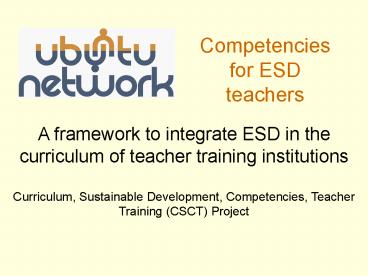Competencies for ESD teachers PowerPoint PPT Presentation
1 / 13
Title: Competencies for ESD teachers
1
Competencies for ESD teachers
A framework to integrate ESD in the curriculum of
teacher training institutions Curriculum,
Sustainable Development, Competencies, Teacher
Training (CSCT) Project
2
ENSI Environment and Schools Initiative
- First phase 1986-1988 11 countries
participated with teachers and students at the
core - The aim gathering experiences and exchanging
them nationally and internationally on the
level of teachers and students. - The promotion of political discourse
- Phase 2 1989-1994 19 countries to anchor
environmental education in schools - Conferences occurred in member countries
which mirrored the thematic focus - ENSI was promoted as a bottom-up approach,
offering a network including teachers and
students facilitated by politics and
research.
3
- Phase 3 1995-Ongoing
- Focus on Eco-schools Teacher Education
- EU Comenius III Project SEED (2002-2005)
publications on Quality Criteria for ESD
schools, tools for evaluation - EU Comenius Project CSCT Competencies for
ESD Teachers (2005- 2008) 15 partners (8
countries) case studies on ESD in Teacher
Education - The major objective of ENSI, an international non
profit organisation is to introduce new
educational methods, to stimulate new types of
collaboration and the development of so called
dynamic qualities of learners. - ENSI Partners Council of Europe UNESCO
Governments who make the commitment to ESD
4
- ENSI received European funding (Comenius 2) and
developed a competency model for teachers of ESD
entitled the CSCT Project. - The present Comenius-2-project, CSCT (Curriculum,
Sustainable development, Competences, Teacher
training) was developed as a response to the call
of the UNECE Ministers of the Environment in 2003
for including education for sustainable
development (ESD) in curricula from pre-school to
higher and adult education to offer curriculum
models to teacher training institutes which are
searching for attainable possibilities to
integrate ESD in their curricula. - The CSCT competence model was developed by the
whole international group in a three year long
process both at workshops and discussions at the
meetings and in between.
5
How to read the Model?
Blue Triangle Professional Dimension
Teacher in society
Teacher in the educational institute
Teacher as an Individual
Professional Dimensions
6
How to read the Model?
Red Triangle Overall Competencies for ESD
Reflecting Visioning
Overall Competencies
Teaching
Networking
7
How to read the Model?
Five Domains
Action
Values Ethics
Future Orientation Learning Processes for
SD Local and global orientation
Emotions
Knowledge
Systems Thinking
8
(No Transcript)
9
The five domains of competencies for the
CSCT-Model
- Five competences domains were identified, of
which each must have a specific profile for ESD. - Even though these domains may appear as separate
elements in the graph, they interact intensively
and are in reality inseparable. - Knowledge specific features of knowledge for ESD
defined included conceptual, factual and action
related knowledge. Knowledge has to relate to
time (past present future) as well as to
space (local global) and it is inter-, trans-,
pluri- or cross-disciplinary constructed. - Systems Thinking The complexity and
interconnectedness of todays world asks for
thinking in systems. Different kinds of systems
are addressed biological, geographical,
ecological, political, economical, social,
psychological ... including interrelationships in
time and space. It implies the awareness of being
part of the living system earth in space and
time.
10
- Emotions Thinking, reflecting, valuing, taking
decisions and acting are inseparably tied with
emotions. Emotional competence is therefore
indispensable for ESD-commitment and processes.
Empathy and compassion play thereby a key role.
Feeling inter-connectedness with the world is
basic for intrinsic motivation in ESD. - Ethics and Values Norms, values, attitudes,
beliefs and assumptions are guiding our
perception, our thinking, our decisions and
actions. They also influence our feelings. The
main guiding principle of ESD is equity (social,
intergenerational, gender, communities ).
Equality between man and nature is explicitly
included only in some SD-concepts. - Action Action is the process, where all the
competences of the other four domains merge to
meaningful creations, participation and
networking in SD. It needs additional special
practical skills, abilities and competences in
the field of project management and cooperation.
All four levels of action have to be considered
for a successful ESD individual,
classroom/school, regional and global. Actions
allow to experience conflicting interests,
change, to be involved (participation), learning
from mistakes, synergies and success. All of them
can increase motivation for further learning and
continuing action if they are chosen wisely.
Actions allow applying the solidarity developed
through empathy and compassion.
11
- For each of these five domains competences were
developed on three different levels - The teacher as an individual connected with
reflection and visioning - The teacher in the educational institution
connected with teaching and communication - The teacher in the society connected with
cooperation and networking - ENSI has developed this framework and currently
UNECE are using it as a framework for their
working group on teacher competencies at a
European level. - Handbook of Competencies for ESD (Education for
Sustainable Development) teachers A framework
to integrate ESD in the curriculum of teacher
training institutes is available for download
at
http//www.unece.org/env/esd/inf.meeting.docs/EGon
Ind/8mtg/CSCT20Handbook_Extract.pdf
12
- Discussion
- What competencies should teachers have entering
the profession? - How can we educate students to achieve these
competencies? - Are we educating teachers to meet these
competencies pre-service, induction and
in-service?
13
Ubuntu Network
- Further information www.ubuntu.ie
- joanne.oflaherty_at_ul.ie

